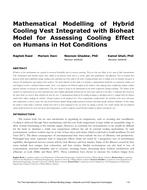Description
Workers in hot environments are exposed to increased irritability and to excessive sweating. They are also very likely to lose some of their concentration. This environment will therefore reduce their ability to do physical work and as a result, affect their performance and efficiency. Not to mention that physical work burns additional energy creating extra metabolic heat that adds to the tally. Cooling methods such as cooling vests are therefore necessary to increase the performance and output of the workers. The main objective of this study is to develop a computational model for an evaporative cooling vest and integrate it with a validated bioheat model. Such a vest improves the thermal comfort of the workers, thus allowing them to efficiently perform outdoor physical activities at elevated air temperatures. The vest’s model is based on the formulation of the direct evaporative cooling technique. The borders of the channel are respresented by an outer insulated layer and a highly hygroscopic material for the inner layer adjacent to the skin. Ventilation fans located at the lower back are used to blow ambient air into the vest. A mathematical model of the cooling technique is developed and it is coupled with the bioheat model which allows studying the workers’ thermal response to the proposed vest. These computations would predict the variation of the torso and mean skin temperature as well as sweat rate and overall thermal comfort during outdoor physical activities and under specific ambient conditions. In this study, the model is tested under a moderate activity level and it is then compared to the case where no cooling is present. The results showed that the proposed system would decrease the torso and mean skin temperatures as well as improve overall thermal comfort of subjects wearing the vest.
Citation: 3rd Intl Conf: Efficient Bldg Design
Product Details
- Published:
- 2018
- Number of Pages:
- 9
- Units of Measure:
- Dual
- File Size:
- 1 file , 1.8 MB
- Product Code(s):
- D-ICEB18-C015




